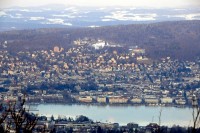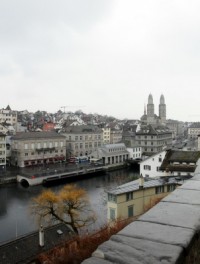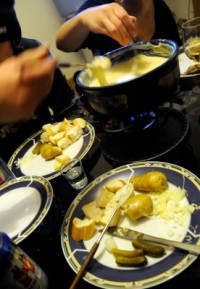Known best for it’s banks, chocolate, and cuckoo clocks, Zurich, Switzerland, has a culinary culture that is sometimes overlooked. On my last trip I asked my Swiss friends to take me out and show me the traditional cuisine of Zurich. It was so good we indulged twice, once for Weiner Schnitzel and once for Fondue.
 Zurich is a precise and industrious town. For example, it is quite uncommon for a bus or train to be late. Located on beautiful Lake Zurich, walks around the city can take you past the contemporary architecture of fifty museums, to quiet parks overlooking the river, or into stunning churches with elaborate, powerfully colorful stained-glass windows. The old part of the city, known as the Altstadt, is the best place to find traditional dining and many of the large dining halls and pubs offer good prices.
Zurich is a precise and industrious town. For example, it is quite uncommon for a bus or train to be late. Located on beautiful Lake Zurich, walks around the city can take you past the contemporary architecture of fifty museums, to quiet parks overlooking the river, or into stunning churches with elaborate, powerfully colorful stained-glass windows. The old part of the city, known as the Altstadt, is the best place to find traditional dining and many of the large dining halls and pubs offer good prices.
 My friends took me to a restaurant in the Altstadt with beer-hall-style dining that featured great house-made dark beer. The menu featured sausages of all kind as well as Weiner Schnitzel. Weiner Schnitzel is technically an Austrian dish, but has a long history in Switzerland, which borders Austria. In its basic form, Wiener Schnitzel is a thin steak of veal pounded very thin, breaded, and fried. It is possibly the inspiration for chicken fried steak. The Swiss version of the dish is called Cordon Bleu Schnitzel, and is two pieces of veal stuffed with ham and cheese and then breaded. Mine came over a large portion of rustic fries.
My friends took me to a restaurant in the Altstadt with beer-hall-style dining that featured great house-made dark beer. The menu featured sausages of all kind as well as Weiner Schnitzel. Weiner Schnitzel is technically an Austrian dish, but has a long history in Switzerland, which borders Austria. In its basic form, Wiener Schnitzel is a thin steak of veal pounded very thin, breaded, and fried. It is possibly the inspiration for chicken fried steak. The Swiss version of the dish is called Cordon Bleu Schnitzel, and is two pieces of veal stuffed with ham and cheese and then breaded. Mine came over a large portion of rustic fries.
 Switzerland is the land of Swiss Cheese, and just as importantly, fondue. Fondue comes in many forms, including chocolate. It’s most common form is made with Gruyère and Emmental cheese, combined with kirsch, a strong fruit brandy distilled from cherries. It is served in a large earthenware pot over a low flame, and long skewers are used to dip bread into the cheese.
Switzerland is the land of Swiss Cheese, and just as importantly, fondue. Fondue comes in many forms, including chocolate. It’s most common form is made with Gruyère and Emmental cheese, combined with kirsch, a strong fruit brandy distilled from cherries. It is served in a large earthenware pot over a low flame, and long skewers are used to dip bread into the cheese.
 My friends and I made fondue at home, however many of Zurich’s restaurants specialize in the dish, and many offer tables specially designed to serve the dish with substantial pots in the middle. My friends pulled out their own large clay fondue pot, and I discovered that we’d be dipping more than bread. As my friends melted the cheese, they said that they do not add the kirsch directly but serve it in shot glasses on either side of the fondue pot. The idea is to dip the bread in the alcohol before dipping it into the cheese, that way you can have more control over how much you want.
My friends and I made fondue at home, however many of Zurich’s restaurants specialize in the dish, and many offer tables specially designed to serve the dish with substantial pots in the middle. My friends pulled out their own large clay fondue pot, and I discovered that we’d be dipping more than bread. As my friends melted the cheese, they said that they do not add the kirsch directly but serve it in shot glasses on either side of the fondue pot. The idea is to dip the bread in the alcohol before dipping it into the cheese, that way you can have more control over how much you want.
With fondue, you can dip anything you like of course, but for some reason I’d never thought of potato. With the potato and chunks of bread my friends also served boiled pearl onions—so good! However, my favorite was the diced onion that you rolled your cheese-covered potato in, right before popping it into your mouth. Tiny Gherkin pickles were also served to accompany the fondue.
As a finale to the meal, I learned that the tiny bit of cheese at the bottom of the pot—usually where the flame directly hits—is the best part of the dish. In my book, it’s hard to beat fried cheese, and it was a satisfying finish to a delicious night.


Comments